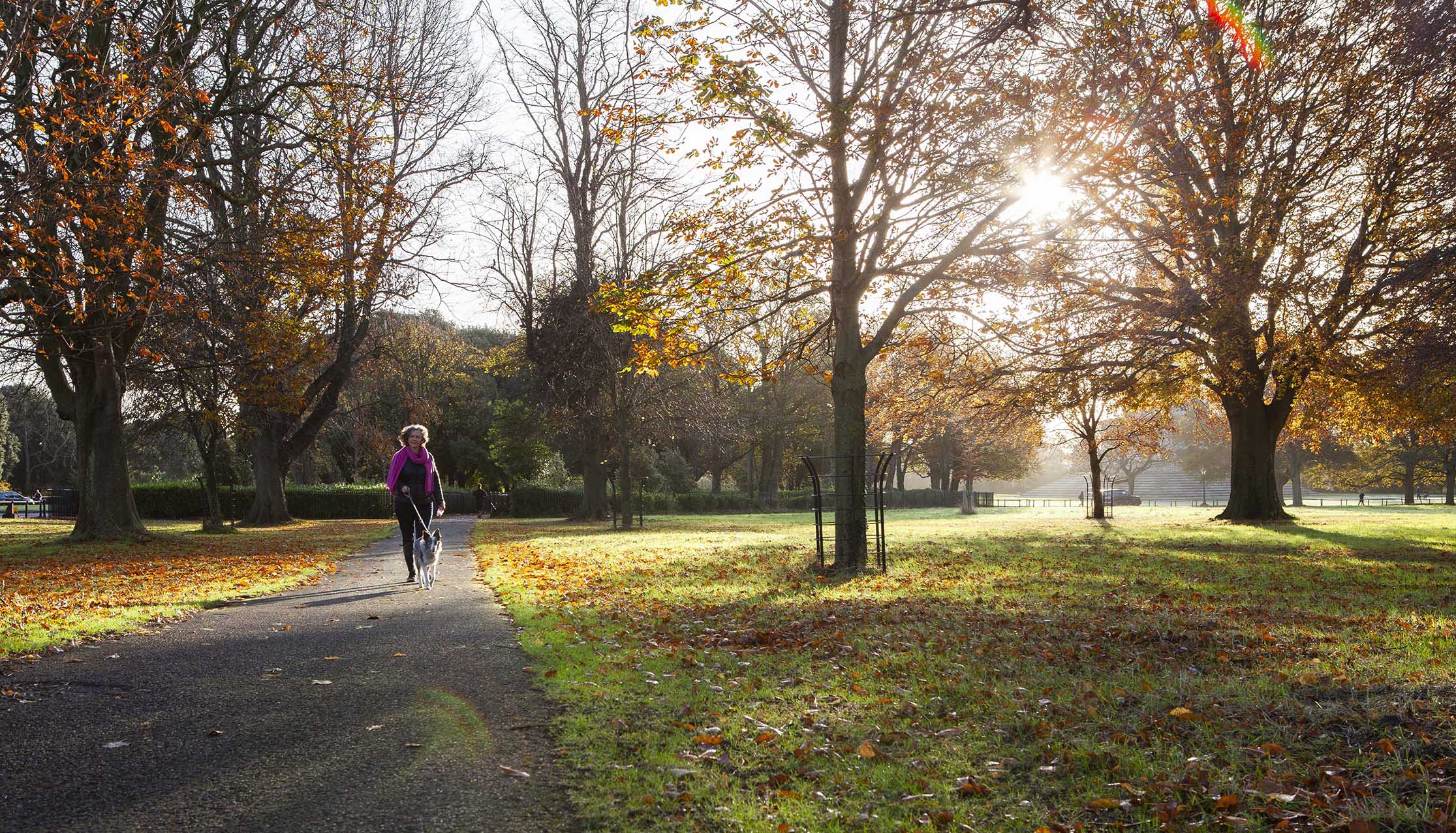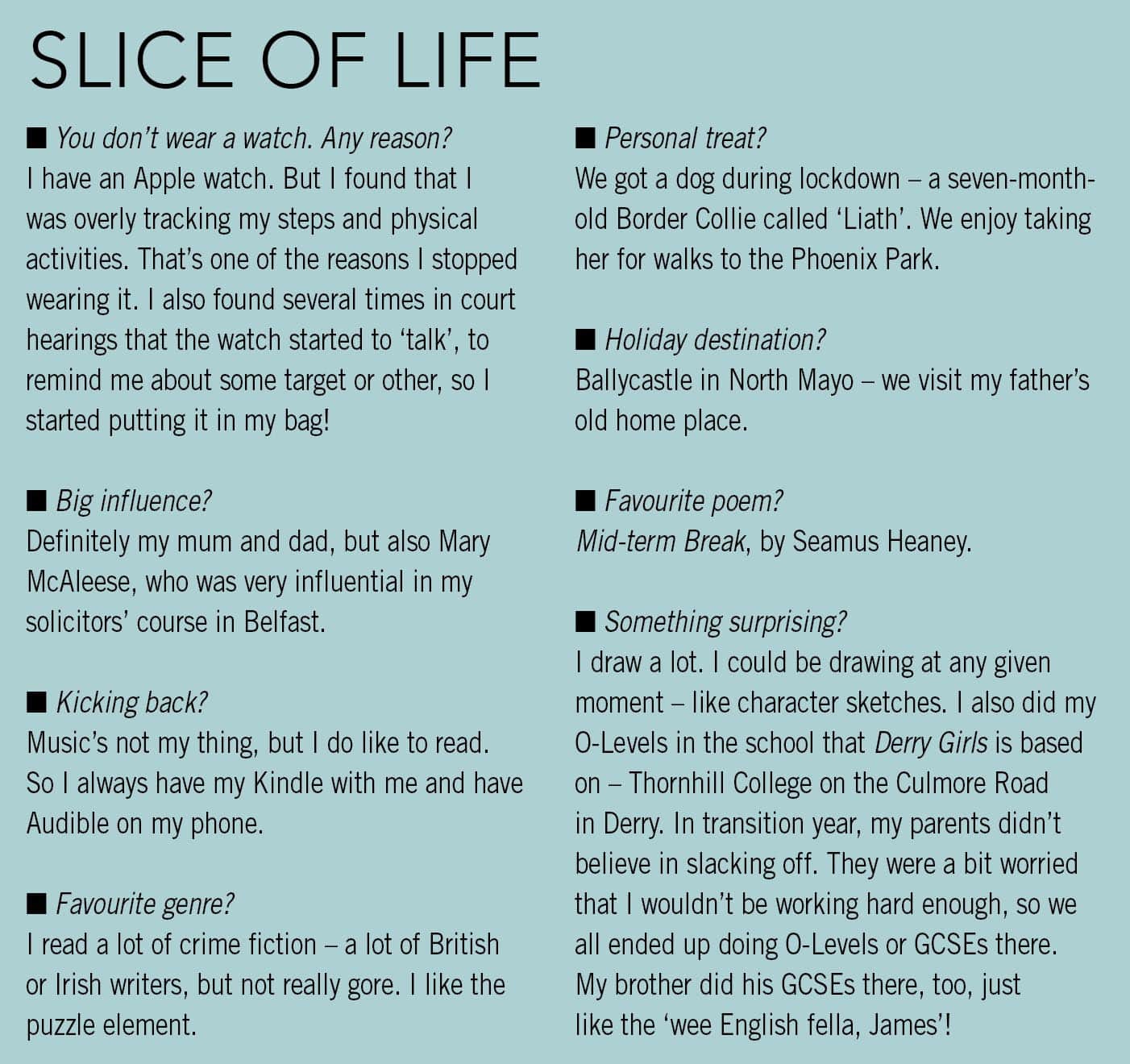Michelle Ní Longáin, who claims Donegal as her home place, possesses some of the same characteristics of that landscape – a calm confidence and a measured assurance – leading one to suspect that it would take something rather significant to disturb her equilibrium.
Michelle’s story started in Limerick, where she was born. The family lived in Tipperary, Birr, Cork city, and finally Letterkenny at the tender age of six. “I arrived in Donegal with a Cork accent!” she laughs.
The moves were due to both parents being teachers. Her dad Seán was a school inspector. They moved northwards where he became CEO of the Donegal Vocational Education Committee, a post he held for 33 years.
Following retirement, he began devilling, and now practises as a barrister. Her mother Eileen took a break from teaching for some years, returning when the children got older.
So what led to Michelle’s decision to opt for law?
“I was interested in a number of things, too many things really. They piloted transition year in my school, so I did quite a number of placements, one of them in a law firm. I also did a lot of debating in school, and I think my parents thought my talent for arguing was quite good!”
Donegal blas
Her move to Queen’s University in Belfast was the unlikely result of visits to the Donegal Gaeltacht for many years. “I knew a lot of people from Belfast as a result, and that made me gravitate towards the city. So I decided to head to Queen’s, during the Troubles.”
How was that for her? “My name is Ní Longáin, so that was interesting! And I didn’t translate it [to English]. I think I realised very early on that people made a lot of assumptions, which I was very quick to correct. I used to phone home in Irish a lot. Years later, I’d have people saying to me, ‘I remember you used to be phoning home in Irish from the halls of residence in Belfast’. We used Irish to speak confidentially as a family, but then I stopped doing that.”
While she qualified as a solicitor in Northern Ireland, it was some time before she travelled to Blackhall Place. She had been thinking of taking the bar at King’s Inns. In the end, she attended the Institute of Professional Legal Studies in Belfast. “It was the automatic place to go to from Queen’s in any event,” says Michelle.
“Mary McAleese was the pro-vice-chancellor at that time. She was very influential.
“Because I had been planning on going to King’s Inns, I hadn’t arranged an apprenticeship, so I ended up walking the streets of Belfast ringing doorbells, asking to speak to various partners about one. I got offered a few, but the one that wanted me most, I wanted them too. That was McClure & Co, located opposite the Law Society in Belfast.
“They were great. My master was a solicitor called Paul Shevlin. He’s recently retired. McClure’s was mainly a trade-union firm, but Paul was very much a social-conscience type of person, very good humoured, and a very good teacher.”
Meaty case
“I ended up – in my first week there – in what was then called an industrial tribunal in a transfer-of-undertakings case, very meaty employment-law stuff. We were representing people who were doing cleaning, portering, and catering work in a hospital.
“There were maybe 11 different respondents – all different employers – against us. I was there as the trainee taking notes and attending the meetings. It was a huge learning curve, but it was great. I really loved it and thought ‘I want to do this’.”
She was taken on by McClure’s subsequently, but times were tough. When she qualified in 1994, many people were leaving the North. “I was kept on for six months, and then a year, but I was looking around. I saw an ad for an English solicitors’ firm that sent a lot of trade-union work to McClure’s. I decided to apply, and ended up moving to England in 1996 to work for Thompsons in Nottingham.
“There was a ceasefire in the North when I applied, but then came the Canary Wharf bombing. And I thought to myself: ‘They won’t want to take me, coming from the North. They’ll be afraid to.’ But they weren’t like that. Thompsons was very big – the biggest trade-union firm in Britain at the time. Ironically, it merged with McClure’s the day after I left Thompson’s.”
Michelle stayed there for three-and-a-half years. “I learned so much. They had 18 offices when I left, with their headquarters in Congress House – the trade-union building. The only employers they would act for were trade unions – and probably the Labour Party. I was the only employment lawyer for the duration when another senior partner had to take premature maternity leave.
“That was a serious learning curve. It was incredibly busy, I was transferring jurisdiction, and they also had race discrimination law, which we hadn’t had in the North. Three months isn’t really long enough to learn your way into a new jurisdiction!”
Moving home
Her decision to move back to Ireland was largely due to the heavy workload she was bearing. “My job was about three times too busy. When I left, they took on three employment law solicitors. I began to realise that I’d quite like to move and, after doing five years of employee work, I thought it might be interesting to move to the employer side.

“When I started in Thompsons, two men had started a few weeks ahead of me. Another woman had begun just two weeks before that. As it turned out, I married one of those men – David Burgoyne from Sheffield – and the other woman married the other!”
Before taking the decision to move home, Michelle had applied for a job at another English solicitor’s firm. She knew the solicitor involved. During the second interview, he said: “I’m offering you a job, but I don’t think you want to come here. I think you want to go home!”
His comment proved to be insightful, because Michelle had already applied for a number of positions in Ireland. When she admitted this, he advised her to contact ByrneWallace.
She moved back to Ireland in October 1999, coinciding with the enactment of the Employment Equality Act. “Similar legislation had come into existence in England in 1996,” says Michelle. “I had religious discrimination experience in Northern Ireland, and race and disability experience in England, so I had expertise that others didn't have in Ireland.”
David followed two years later, and they were married in 2003. He continued working as a solicitor for a number of years in Ireland, but now looks after their children.
Michelle has been with ByrneWallace for 22 years – the law firm is now Ireland’s seventh largest. She is an equity partner and head of the firm’s public sector group, “so it worked out okay!” she jests. When she arrived, there were approximately 70 people working there – the figure is now closer to 300.
No gap year
As a senior partner in the firm, is she planning to take a ‘gap year’ during her presidential term?
“I don’t believe anyone has done so in recent years. I’ll be taking my presidential responsibilities very seriously, but I’ll continue doing client work and will be involved in the running of the firm,” she says.
So what does she most want to achieve during her year as president?
“The one thing that overarches my presidential term at present is the Dignity Matters report on bullying and harassment in the profession – and how the Law Society is planning to deal with its recommendations.”
Were its findings a massive shock, despite the similar conclusions in the IBA Us Too report?
“I think it really brings it home to you. It’s more ‘real’ in some respects. It means that when you’re reading the Dignity Matters report, you know that you almost certainly know somebody who has contributed some of the quotes, and that’s a hugely powerful thing. And I think it also highlights that none of us hasn’t observed, or certainly hasn’t in some way encountered, the behaviours that are referred to there.”
Sound of silence
Is it too strong to suggest that perhaps most of us have contributed in some way to bullying or harassment in the profession, given the strength of the findings in the report?
“I think ‘contributed’ is too strong a suggestion, but we’ve certainly not done enough to prevent it. Silence is a problem, or turning a blind eye. So we have to look at it and be brave enough to face it.
“The comment has been made to me that, given that the profession is one that people normally go to for help in relation to bullying, harassment and sexual harassment matters, isn’t it ironic that solicitors themselves don’t report it within their own profession?
“I think it shows that there’s a difference between advising in your role as a lawyer, and looking after yourself. It shows that we all have the same difficulties in reporting matters – the same difficulties that are encountered across all professions and workplaces.
“I want this report to be something that is spoken about and addressed in all of the organisations in which our members work – whether those are firms or in-house roles in the public or private sectors. We need to recognise that there may be a potential problem in the place where we work that we need to deal with – and that it’s actually named.”
This time next year
Will the profession look significantly different this time next year?
“We’re only really getting started – I don’t think you can transform the profession in a year. I think that people are more receptive to hearing about this now – perhaps due to COVID. People seem to be more open to talking about difficult things.
“I’ll be seeking to lead by influencing and directing and guiding. So I hope that we will have achieved a significant change in the attitude of our members, whether they’re employers, employees, or self-employed people who deal with others.
“And that we have caused people to stop and think about how they engage with others, and to understand that, if the way that they’re being treated is not correct, then there’s a route for them to raise it.”
Another major presidential theme for Michelle Ní Longáin is diversity, inclusion, and women in leadership. “I’m the fifth woman out of 151 presidents – it’s extraordinary to say that. That said, in this year’s Council election, 50% of the successful candidates are women, so that’s an interesting development. But on the day that I took the chair, I also pointed out to our Council that we lack diversity among our own cohort.
“Whatever amount of gender diversity we have, we have less of everything else, so we need to work on encouraging a more diverse cohort to get involved on the committees and on the Council of the Law Society.”
Very different experiences
The new president is also focused on business recovery plans for the profession: “Our members have had very different experiences in their businesses as a result of COVID. Everybody has had to change – some have had significant adverse business impacts; some to a lesser degree.
“My major desire is that we focus on the central role of the lawyer in our society, which is paramount. Each one of us is the face and voice of the trusted solicitors’ profession. So, central to Dignity Matters and to gender equality, diversity, and inclusion is the need to emphasise that solicitors are central to society.
“We need business recovery for solicitors – but also for solicitors to be at the centre of business and societal recovery.”

Mark McDermott is editor of the Law Society Gazette
Read and print a PDF of this article here.